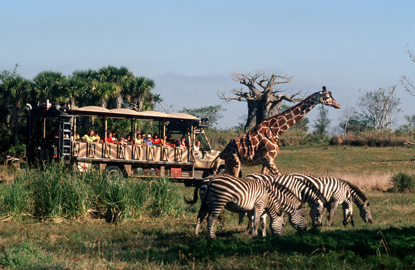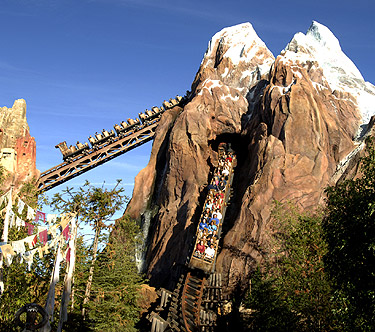| Route 66 | Cities | Beaches |
Beech Bend |
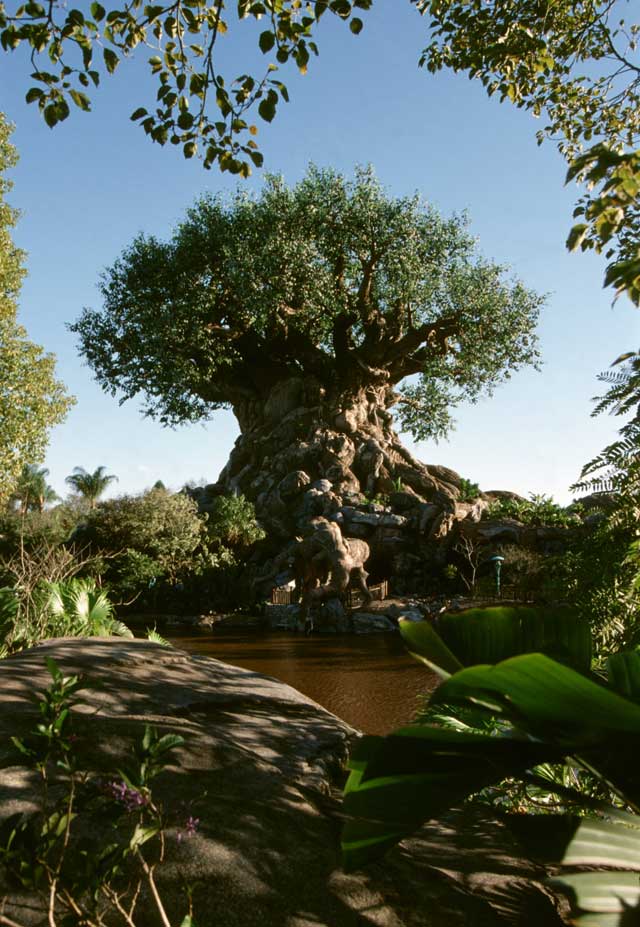 |
Animal Kingdom
|
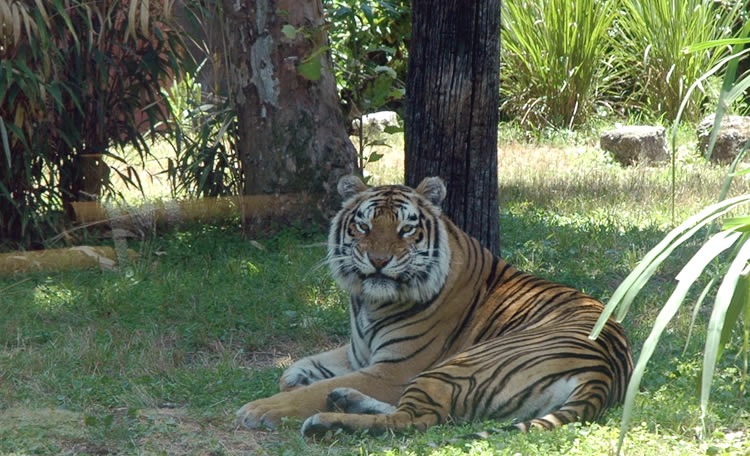 |
| Getting There | Rides | Shows | Other Activities |
|---|
Animal Kingdom is a magical mixture of zoo, animated cartoon world and cutting edge amusement park. The Kilimanjaro Safari gets you unnervingly close to lions, tigers, giraffes, zebras, elephants and other African animals in a careful recreation of their native savannah, seen here at right. If that's still not close enough, you can hike the Pangani Trail and look them right in the eye, as seen above right. There's a riverboat cruise, a white water rafting ride and the incredible Everest Expedition roller coaster. Towering above all of this is the massive Tree of Life, seen above left. Once kids reach middle school, most of them are more enthralled by this park than by the Magic Kingdom. |
|
| Rides | Magic Kingdom | Hollywood Studios | Blizzard Beach | Typhoon Lagoon | Universal Studios | Islands of Adventure |
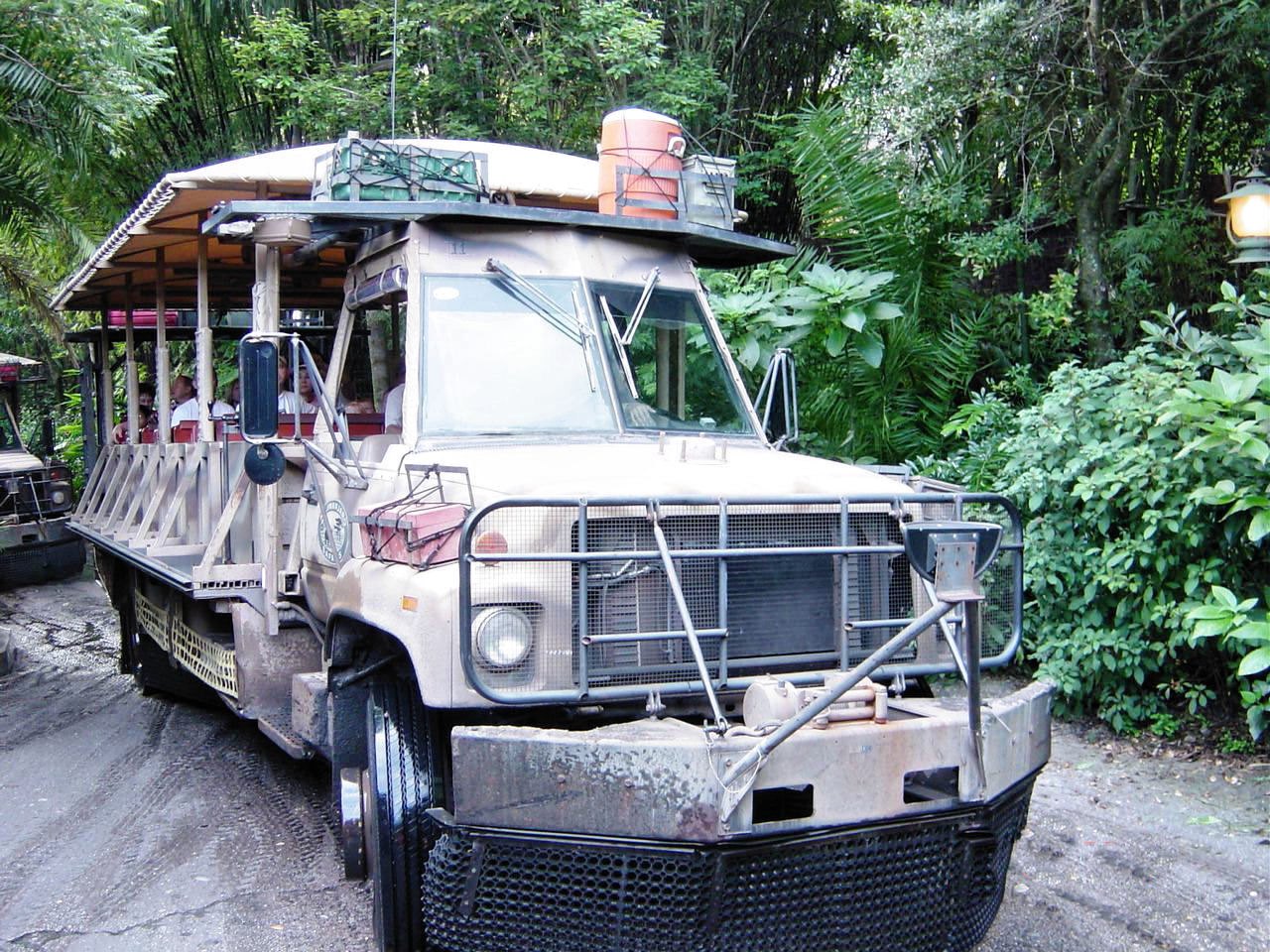 |
The Kilimanjaro Safari is the best ride of its kind this side of Africa. You board a 32 passenger Nairobi Safari Truck and wind along a dirt road, complete with stream fordings. The Harambe Wildlife Preserve is the same size as the whole Magic Kingdom Park. It has been carefully planted with authentic African Savannah grasses and trees and stocked with every kind of animal common to the Savannah. These are actual wild animals so they roam free. If a rhino blocks your way you wait until it ambles off the road. The seats are newly padded but this is still a rough, jostling ride. Sitting up front will give you a somewhat less bouncy ride. The rear seats are quite rough; teenagers love them. You need to keep binoculars and cameras handy because you never know what animals may be just around each bend. However, for best viewing, ride the first few rides in the morning and the last few rides late in the day. Between about 11 and 3 the animals tend to move into the shade and nap. All the attention is focused on animals, but the plants of the Savannah are just as impressive, especially the gigantic and wierd looking Baobob Trees, which are supposedly growing upside down. The giant termite mounds are also pretty impressive. |
|---|
As soon as you come off the Safari, you have to go immediately next door and hike the Pangani Forest Trail. This is one of the more unique experiences at any zoo or amusement park in the world, more like what you would expect in a National Park. You're on your own, out for a hike through a lush, tropical rainforest and across a wide savannah. You can walk as fast or slow as you like, stop as often as you want, rest on occasional benches, and take photos. Anyone who hikes would love to go hiking on another continent, like Africa. Time and cost do not usually allow such a luxury, so this is the next best thing. We advise you to fill your water bottle, take a few snacks, and enjoy an hour respite from the noise and crowds. As with the Kilimanjaro Safari, all the hype focuses on the mammals, but the plants, flowers, birds, fish and insects are just as fascinating if not more so, especially if you have good telephoto and close up lenses. |
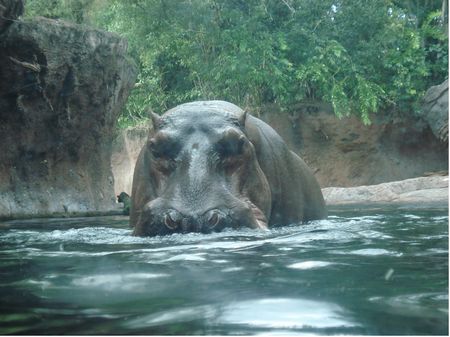 |
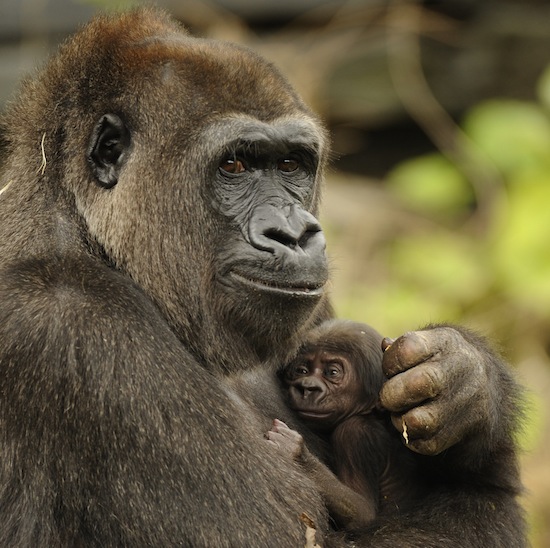 |
However, there's no doubt you'll remember your up close and personal encounters with these mammals. Most people come back raving about the Meerkats, Hippopatami, Okapi (first cousin to the giraffe), African Antelope, and others. But there's a hut set up with windows into the ground where you can view the Naked Mole Rats. ( These are unique for two reasons. First, they're the only hairless rodents. Second, their colonies are like beehives : they have a queen, soldiers, drones, etc.) Just before the river you'll come to a Carmine nesting area. This is worth some time. Carmines are the only birds in the world that live on bees. Watching them eat a few bees is bizarre. As you approach the river there's an underwater viewing area with views of Hippos (the males here weigh five tons each; Hippos are cousins to whales and porpoises) swimming and feeding. You might consider a long stop at the Meerkat Colony. In addition to their entertaining social behavior, it's fun to watch a Meerkat eat a scorpion or two. And toward the end of the trail you hike past a colony of Lowland Gorillas. They're vegetarians and quite peaceful, but their tribal society is complex and well organized. There's a large view area as you first approach the colony and you may find it quite crowded, as almost everyone loves gorillas (maybe because we share 98% of their DNA). However, there are two other viewing areas past this one, so feel free to move on rather than wait in line. If you hike this trail, mind your manners. Be quiet and don't run, wave your arms or otherwise scare the animals. They're what your coming to see. And others may wish to hear the birds. |
The Kali River Rapids may not be the greatest rafting ride in the country (Kennywood Park's is longer and better), but it is certainly the best themed. The theming begins with the line. It meanders through lush tropical rainforest, an elaborately detailed temple, and as you approach the river an African village. Once on the water, you climb a long lift hill and begin your river journey. With Mt. Everest looming in the background, you wind and twist through more rainforest and pass a disturbing scene of deforestation, with debris and fires surrounding you. Your raft plunges down an exciting 30 feet waterfall, through several tunnels and caves, all the while tilting and spinning in choppy waves and the occasional geyser or waterfall pouring in from side streams. You're guaranteed to get soaked, so you have to deal with it. We recommend you bring a pair of sandals, a poncho (or rain jacket) and towel just for this ride. Leave the towel and your shoes and socks at the loading station so when you get off you can use the towel to dry off and change back into dry socks and shoes. This ride is too short for the 60-90 minute lines it usually attracts. You definitely need to use Fast Pass here. |
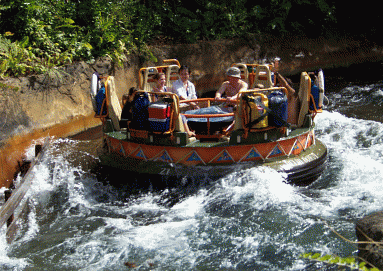 |
|
Expedition Everest is not the most intense roller coaster out there. It doesn't take you upside down, has no 100 ft. drops, and the trains only travel 55 mph. Disney touts this as a family thrill ride. But it's still one of the great coasters in America due to rich theming and technical execution. As you come through the line you're immersed in a ruined temple and Himalayan village and learn about the Abominable Snowman (Yeti) jealously guarding the mountain. Supposedly you're going on the train to the base of Mt. Everest for a mountain climbing expedition, but it becomes clear the Yeti finds this railroad annoying. You climb the first lift hill, drop down into a crevice, climb the second and much larger lift hill, and roar down the ride's biggest drop. Unfortunately, as you climb the next hill and begin to drop again, you see the Yeti in the distance tearing up the track. Your train barely manages to stop in time, pauses for a moment, then begins rolling backward. Without your noticing, behind you, a switch has moved, so you roll backward onto a different track. This one takes you backward into pitch darkness. You plunge steeply down and through a tight helix which is extremely disorienting. Things become even more disorienting as you emerge into a deep crevice and the Yeti is attacks your train. Narrowly escaping, the train begins rolling forward. Again, while you were focused on the Yeti, a switch has moved, and you again move to a different track. You emerge into the daylight and plunge down another fairly long, steep drop, then finish the ride as a regular coaster would. The Yeti has its own fan cult, so you need to go early and use FastPass. |
| Discovery River Cruises have been discontinued but there is talk of reviving them so we include them here. Animal Kingdom is the largest of the Disney parks and the walk from one end to the other is quite long. The boats were intended as a transportation system to get people back and forth between Asia, Africa, Discovery Island and Camp Station. Visitors quickly found that the boats provided a scenic, relaxing cruise around the park. They were also popular with photographers. Each boat held 62 people and including stops a round trip took about half an hour. There were six boats running and a seventh in reserve. The ride became a victim of its own popularity. Disney received a huge number of complaints about the long lines. People figured out that they could walk to the other end of the park in less time than they had to wait for a ride. Disney calculated that it could not add enough boats to solve the line problem, so the cruises became the first original Animal Kingdom ride to close. The real problem was when AK opened, there were too few rides, so people expected the boats to be entertaining instead of mere transportation. Now that there are enough rides to satisfy guests, it may be safe to bring back the boats. | 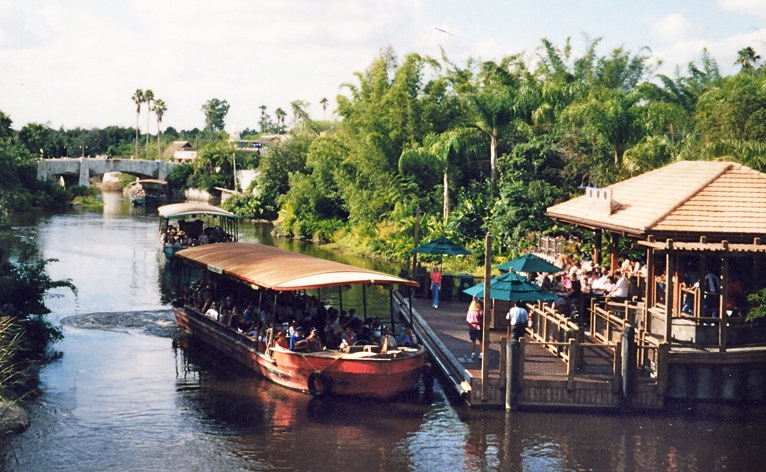 |
|---|
 |
The second hiking experience in the park is the Maharajah Trek, a path through the jungle of Indonesia. This is another trail you hike at your own pace, stopping to rest, snack or take photos as you wish. It is also a botanical wonderland, accurately including plants native to Southeast Asia. The stars of this hike are the Komodo Dragon (left), the Giant Bats, 50 species of exotic birds, and the Bengal Tigers (top right). Since the Dragon (it's the world's largest lizard, a wolf sized reptile, living descendant of the dinosaurs, and a threat to people and animals in Asia where it lives) and the Tigers are potentially dangerous, they're separated from the trail by cleverly disguised barriers. You won't even notice them, and you can still get pretty close to the animals, certainly close enough for good photos or to get your adrenalin flowing. Included along the trail are crumbling temple ruins and beautiful murals. Make sure to fill your water bottle and carry snacks on this hike. Maharajah Trek is next to the Kali River Rapids and Everest Expedition, so you could use your Fast Pass privileges over there and then spend your waiting time on the Maharajah Trek. This Komodo Dragon has slashing claws and a razorsharp bony gum ridge where mammal teeth are. It can inflict some pretty bloody damage on an animal or person walking down a jungle trail; its favorite prey is an adult deer. The Komodo Dragon usually lurks back in the shadowy underbrush and lunges out at whatever passes. Here in the Animal Kingdom you're protected by a natural barrier (because of his weight and awkward limbs, he cannot easily move vertically, and notice we're above him), but as you can see from this photo, you can still get close enough to feel a little nervous. When the Komodo Dragon gets excited, blood flows into that flickering tongue and turns it bright red. This photo catches the tongue in stop action extended all the way out, but actually it flickers back and forth so fast it's a blur. It was this blurred red impression that led people to believe this dragons and its larger cousins were breathing fire. The Komodo Dragon is thought to have devolved down in size over the last couple of thousand years and even as recently as the time of the Pharoahs and the Emperors was a lot bigger than this. Females who go without mating for more than a year can lay self fertilized eggs that hatch into normal males and females, so if one female washes up on an island she alone can create a new population on that island, a trait inherited from the Dinosaurs. |
|---|
|
|||
|
